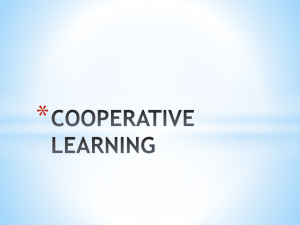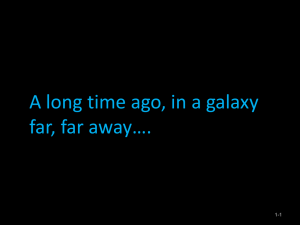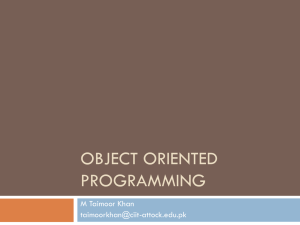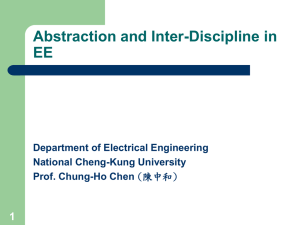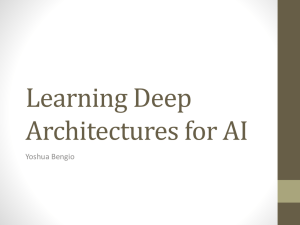Level of Abstraction in Software Design
advertisement
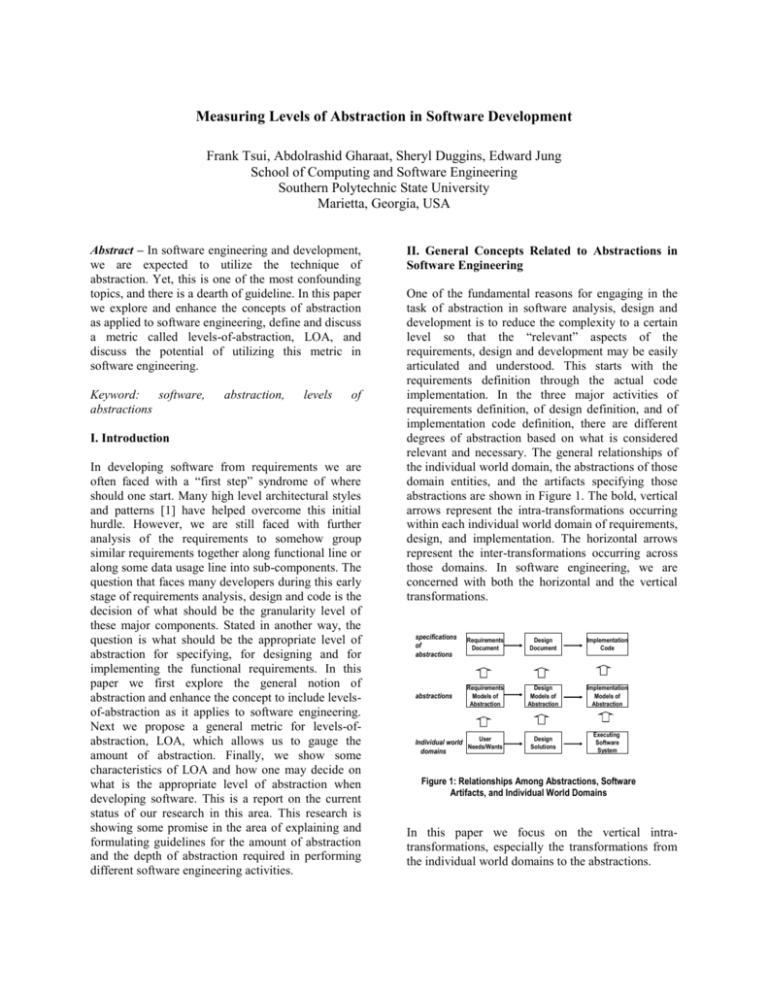
Measuring Levels of Abstraction in Software Development
Frank Tsui, Abdolrashid Gharaat, Sheryl Duggins, Edward Jung
School of Computing and Software Engineering
Southern Polytechnic State University
Marietta, Georgia, USA
Abstract – In software engineering and development,
we are expected to utilize the technique of
abstraction. Yet, this is one of the most confounding
topics, and there is a dearth of guideline. In this paper
we explore and enhance the concepts of abstraction
as applied to software engineering, define and discuss
a metric called levels-of-abstraction, LOA, and
discuss the potential of utilizing this metric in
software engineering.
Keyword:
software,
abstractions
abstraction,
levels
of
I. Introduction
In developing software from requirements we are
often faced with a “first step” syndrome of where
should one start. Many high level architectural styles
and patterns [1] have helped overcome this initial
hurdle. However, we are still faced with further
analysis of the requirements to somehow group
similar requirements together along functional line or
along some data usage line into sub-components. The
question that faces many developers during this early
stage of requirements analysis, design and code is the
decision of what should be the granularity level of
these major components. Stated in another way, the
question is what should be the appropriate level of
abstraction for specifying, for designing and for
implementing the functional requirements. In this
paper we first explore the general notion of
abstraction and enhance the concept to include levelsof-abstraction as it applies to software engineering.
Next we propose a general metric for levels-ofabstraction, LOA, which allows us to gauge the
amount of abstraction. Finally, we show some
characteristics of LOA and how one may decide on
what is the appropriate level of abstraction when
developing software. This is a report on the current
status of our research in this area. This research is
showing some promise in the area of explaining and
formulating guidelines for the amount of abstraction
and the depth of abstraction required in performing
different software engineering activities.
II. General Concepts Related to Abstractions in
Software Engineering
One of the fundamental reasons for engaging in the
task of abstraction in software analysis, design and
development is to reduce the complexity to a certain
level so that the “relevant” aspects of the
requirements, design and development may be easily
articulated and understood. This starts with the
requirements definition through the actual code
implementation. In the three major activities of
requirements definition, of design definition, and of
implementation code definition, there are different
degrees of abstraction based on what is considered
relevant and necessary. The general relationships of
the individual world domain, the abstractions of those
domain entities, and the artifacts specifying those
abstractions are shown in Figure 1. The bold, vertical
arrows represent the intra-transformations occurring
within each individual world domain of requirements,
design, and implementation. The horizontal arrows
represent the inter-transformations occurring across
those domains. In software engineering, we are
concerned with both the horizontal and the vertical
transformations.
specifications
of
abstractions
Requirements
Document
Design
Document
Implementation
Code
abstractions
Requirements
Models of
Abstraction
Design
Models of
Abstraction
Implementation
Models of
Abstraction
User
Design
Solutions
Executing
Software
System
Individual world
Needs/Wants
domains
Figure 1: Relationships Among Abstractions, Software
Artifacts, and Individual World Domains
In this paper we focus on the vertical intratransformations, especially the transformations from
the individual world domains to the abstractions.
The term abstraction used in the form of a verb, as
represented with bold vertical arrows in Figure 1
from individual world domain to abstractions, would
include the notion of simplification. Simplification
represents the concept of categorizing and grouping
domain entities into components and relating those
components. We simplify by:
(i)
reduction and
(ii)
generalization.
By reduction, we mean the elimination of the details.
Generalization, on the other hand, is the identification
and specification of common and important
characteristics. Through these two specific subtasks
of reduction and generalization we carry out the task
of abstraction. Rugaber [7] states that design
abstraction is a “unit of design vocabulary that
subsumes more detailed information.” This notion of
abstraction via simplification is also similar to the
notion explicated by Wagner and Deissenboeck [9]
and Kramer [3]. Thus via the process of abstraction,
we aim to simplify or decrease the complexity of the
domain of software design solution by reducing the
details and by generalization. One may view the well
established concept of modularization in software
engineering as a specific technique within the broader
context of abstraction.
The employment of abstraction in software
engineering where we aim to reduce complexity is
certainly not just limited to the domain of software
design. As Figure 1 shows, many other domains also
employ abstraction. At the early stage of software
development, the requirements represent the needs
and wants of the users and customers. The user
requirement is represented in some form of the user
business flow, user functional needs, user
information flow, user information representation,
user information interface, etc. Each of these
categories is an abstraction of the user world.
Different degrees of abstraction may be employed [3,
4, 8, 11] depending on the amount of details that need
to be portrayed in the requirements. This intratransformation is represented by the vertical arrow
from User Needs/Wants domain to Requirements
Models of Abstraction in Figure 1.
As we move from requirements towards the
development of the solution for the user
requirements, a new form of abstraction takes place.
The new form of abstraction is necessitated due to the
fact that the solution world includes the computing
machines and other logical constructs that may not
exist in the original user requirements. One of the
first artifacts from the solution side is the software
architecture and high level design of the software
system. At this point, the abstraction, once again,
should not include all the details. The intertransformation of the requirements models of
abstraction to the design models of abstraction is
shown as the horizontal arrow in Figure 1. Note that
the box labeled “Design Models of Abstraction” is
the result of two types of transformations:
a)
inter-transformation from the requirements
domain and
b) intra-transformation within the design
solution domain.
The “Implementation Models of Abstraction” box in
Figure 1 represents the packaging/loading models of
the processes, information and control of the
mechanical execution of the solution in the form of
source code to satisfy the functionalities and the
system attributes described in the requirements and
design documents. Thus it is a result of the intertransformations from requirements models of
abstraction through the design models of abstractions
and the intra-transformations from the actual
software execution domain.
The “Implementation Code” box is the specification
of this abstraction. The actual execution of the
Implementation Code and the interactions with the
users formulate the final deployment of the source
code abstraction or the “Executing Software System”
box in Figure 1. Thus the employment of various
abstractions and the transformations of these abstract
entities are crucial, integral parts of software
engineering.
III. Measuring Abstraction
Abstraction, both as a verb and as a noun, is a crucial
element in software engineering. As a verb, we have
defined it as the activity of simplification, composed
of reduction of details and the generalization of
crucial and common attributes. Now, it is relevant to
ask how much abstraction would be appropriate so
that we can arrive at the “Implementation Code” box
and the “Executing Software System” box in Figure
1.
Jackson [2] admonishes us that we need to be careful
with abstraction and the degree of abstraction
because so many seemingly good designs fall apart at
implementation time. His warning is well founded in
that many design abstractions, the noun, are often
missing some vital information for the detail coding
activities. In the past, we have utilized the technique
of decomposition to move from abstraction to details.
However, if our abstraction is generalizing too much
to not include the vital information, then Jackson’s
warning will turn into reality. The levels of
abstraction should be different for various software
artifacts and be dictated by the purpose of
abstraction. Wang [10] has expressed a similar
concern and defined a Hierarchical Abstraction
Model for software engineering; his hierarchical
model of abstraction describes the necessary levels of
preciseness in representing abstractions of different
objects. He argues for more precise, rigorous and
formal ways to describe different software artifacts
such as software architecture and design. In terms of
our Figure 1, Wang addressed the issue of rigor of
specifications of abstraction in the requirement and
design documents, not how much should be included
in the abstraction.
The how much, or the amount, of abstraction is a
reflection of the result of the simplification activity,
which is in turn composed of reduction and
generalization activities. Measuring the amount of
abstraction is gauging the extent of reduction and
generalization that took place. For example, this may
be possible in the requirements domain. We may
consider the set of the original requirements
statements of needs and wants as X in the “User
Needs/Wants” box in Figure 1. Then, |X|, the
cardinality of X is a count of the raw requirement
statements collected through some solicitation
process. These are the pre-analysis requirements
statements. We then designate Y as the statements in
the “Requirements Models of Abstraction” box. The
cardinality of Y, |Y|, is a count of the statements that
resulted from requirements analysis, which include
activities such as organizing, grouping, prioritizing,
etc. In other words, the post-analysis of the solicited
requirements is a form of abstraction of the raw user
needs and wants requirement statements. Then the
“difference” between |X| and |Y| is:
(Level-of-Abstraction)REQ. = |X| - |Y|.
(Level-of-Abstraction)REQ represents the “difference”
between pre-analysis and post analysis of
requirements, and it may be considered a metric of
abstraction for requirements.
Since simplification is a vital characteristic of
abstraction, we expect |Y| to be less than |X|. Thus we
will need to further refine this definition with the
constraint that if |Y| is not less than |X|, then no
abstraction activity really took place. We will also
take the subscript, REQ, off the terminology for the
general case. In general, let X be the statements in the
domain world, and let Y be the set of statements in
the abstraction, the noun, then
Level-of-Abstraction (LOA) = |X| - |Y|,
if |X| > |Y|
else
=0
Note that when the abstraction activity is carried to
its extreme, |Y| should just be 1. For example, all the
raw requirement statements of needs and wants are
abstracted into one abstract statement. Thus Level-ofAbstraction is bounded by (|X| - 1) and 0.
This also implies that Level-of-Abstraction is heavily
influenced by |X|. Consider two domain world
representations, X1 and X2, where |X1| > |X2|, with
their respective abstractions of Y1 and Y2. If |Y1| =
|Y2|, then |X1|-|Y1| > |X2|-|Y2|. Thus Level-ofAbstraction states that more abstraction, the verb,
took place in the X1 to Y1 scenario than the X2 toY2
case.
A more interesting consideration is the situation
where we have two different abstractions, Y1 and
Y2, from the same world domain, X. Assume |Y1| <
|Y2|, then (|X| - |Y1|) > (|X| - |Y2|). Thus, as we
would expect, Level-of-Abstraction from X to Y1 is
more than that of X to Y2.
While we are not certain of the real interval size
between one Level-of-Abstraction and its immediate
next level, we can say that Level-of-Abstraction is an
ordinal metric that provides us a sense of ordering.
IV. Measuring Requirements Abstraction:
In this section we will further explore the Level-ofAbstraction
measurement
concept,
using
requirements analysis as an example. Note that it is
very likely that X and Y are not expressed with the
same language. English sentences and some diagrams
may be the main ingredients of the wants and needs
expressed by the users and customers. The result of
requirements prioritization, categorization and
analysis is some form of abstraction, Y, which may
be expressed with a Use Case Diagram. The amount
of requirements abstraction defined as the
“difference” between pre and post analysis of
requirements deserves some further explanation and
illustration here.
Suppose there are X = {x1, x2, ---, xz} raw
requirement statements. The set X may contain a
variety of statements, referring to functionality, data
and other attributes. A common type of abstraction
that may be employed is to categorize and group X
by functionality. Thus only a subset of X, X’, is
addressed. X’ is the subset of requirement statements
that addresses functionality needs. Let X’ = {xx1,
xx2, ---, xxn}, where |X’| ≤ |X|. The subset X’ is
analyzed and partitioned into some set of categories
of functionalities. Let us call this partitioned set, set
Y. Y may look as follows.
Y = {(xx1, xx2); (xx3, xx5, xx10); ----}
Every functionality xxi € X’ is in one of the partitions
of Y and in only one of the partitions. Renaming the
partitioned set Y as follows, yields:
Y = {y1, y2, ----, yk}
where
y1 = (xx1, xx2)
y2 = (xx3, xx5, xx10)
.
.
Yk.
The set Y may be represented by a Use Case diagram
where y1, y2, ---, yk are the named interaction
represented as “bubbles” in the Use Case diagram.
Clearly there is more than one way to partition X’;
thus there may be different Y’s. A use case diagram
with one “bubble” would be an extreme case as well
as a use case diagram with a bubble for each xxi. The
extreme points of |Y| = 1 nor |Y| = |X’| would be very
rare.
Now consider a specific case where the domain set X
has 4 functional requirements x1, x2, x3, x4. Then
there are the following partitioning sets, P’s for
different functional abstractions, Y’s.
P0 has Y01 = {(x1); (x2); (x3); (x4)} = X
P1 has Y11 = {(x1); (x2); (x3,x4)},
Y12 = {(x1); (x3); (x2,x4)},
Y13 = {(x1); (x4); (x2,x3)},
Y14 = {(x2); (x3); (x1,x4)},
Y15 = {(x2); (x4); (x1,x3)} and
Y16 = {(x3); (x4); (x1,x2)}
P2 has Y21 = {(x1); (x2,x3,x4)},
Y22 = {(x2); (x1,x3,x4)},
Y23 = {(x3); (x1,x2,x4)}and
Y24 = {(x4); (x1,x2,x3)}
P3 has Y31= {(x1,x2); (x3,x4)},
Y32= {(x1,x3); (x2,x4)}, and
Y33= {(x1,x4); (x2,x3)}
P4 has Y41 = {(x1,x2,x3,x4)}
At P0, there is only one abstraction, Y01, which is
the same as the original requirement set X. So Levelof-Abstraction is |X| - |Y| = 0. There is no abstraction
at P0. At P1, any of the Y1x has a cardinality of 3. So
at P1, |X| - |Y| = 4 – 3 = 1. The Level of Abstraction
is 1. At P2, the Y2x’s are grouped differently and
each has a cardinality of 2. Thus, at P2, |X|-|Y| = 4-2
= 2. P3 partitioning has the functionalities grouped
differently, but each Y3x has a cardinality of 2, just
like those in P2. At P3, |X| - |Y| = 4 -2 = 2. Thus all
partitions in P2 and in P3 are at the same Level-ofAbstraction, 2. Finally at P4, there is again only one
abstraction, Y41, which combined all four
functionalities into 1 category. Thus at P4, |X| - |Y| =
4 – 1 = 3. The Level-of- Abstraction is the highest
here.
From this example, one can easily see that abstraction
of functionalities into groups for a relatively small set
of four functional requirements has many choices. In
this case there are 15 choices and there are 4 different
Level-of-Abstraction, namely 0 through 3. Coming
up with the one “best” abstraction is not an easy task
even with this small example.
V. General Theorems
We have shown that for a |Y| = k, there may be
several different abstractions with that same
cardinality. That is, given an abstraction level j, there
may be more than one solution.
Theorem 1: For Level-of-Abstraction = |X| - |Y| = j,
there exists more than one abstraction or partitioned
set, Y, at that Level-of-Abstraction, unless j = 0 or
j = |X| -1.
Proof: Given |x| - |y| = j, if j=0 then |x| - |y| = 0 and
there is no abstraction. If |x| - 1 = j, then |y| has only
1 category with all functionalities included, so |x| - |y|
= |x| - 1, which is the highest level of abstraction.
From combinatorics, we know for any set with n>0
elements and r an integer such that 0 ≤ r ≤ n, then the
number of subsets that contain r elements of S is
n!__ . Hence for all the values in between, there
r!(n-r)!
will be partitioned sets.
Note that the different Level-of-Abstraction’s as
shown in our simple example of P0 through P4 form
a partially ordered set. Next we introduce an Up and
a Down operator on Level-of-Abstraction. Given a
Level-of-Abstraction, Px, and a Level-of-Abstraction,
Py, any x€Px and y€Py, then UP and Down operators
are defined a follows:
UP(x,y) = x if Py ≤ Px and
= y otherwise.
Down(x,y) = y if Py ≤ Px and
= x otherwise.
Theorem 2: Set of Level-of-Abstractions, with the
operators of Up and Down form a lattice structure.
Proof: The set of Level-of-Abstraction is a partially
ordered set, or a Poset. A lattice is a Poset in which
any two elements have a lowest upper bound (lub)
and a greatest lower bound (glb). The Up operator
provides us the glb and the Down operator provides
us the lub. Thus the set of Level-of Abstraction forms
a lattice.
VI. SUMMARY AND RESULTS
In this paper we explored the general notion of
abstraction as applied to software engineering. We
further proposed a general metric for levels-ofabstraction, LOA, which allows us to gauge the
amount of abstraction. Lastly, we showed some
characteristics of LOA and indicated how one may
decide on the appropriate level of abstraction when
developing software.
This paper indicates our preliminary work in this
area. Our next task is to further explore the properties
of our Up and Down operators. For example, we
believe for the UP operator, the glb is the identity
element. With it, the set of LOA forms a Group. With
the Down operator, the identity element is the lub.
Thus with both Up and Down and their respective
identity elements, the set of LOA may be a Ring. We
further will explore the fact that when you go Up and
Down in LOA, how do you know which gives the
best coverage of abstraction? Our initial idea is that
the top level of abstraction may not be the best in
terms of design.
References
1. D. Garlan and M. Shaw, “An Introduction to
Software Architecture,” CMU-CS-94-166, Carnegie
Mellon University, Pittsburgh, PA, 1994.
2. D. Jackson, Software Abstractions Logic,
Language, and Analysis, MIT Press, 2006.
3. J. Kramer, “Is Abstraction the Key to
Computing,” Communications of the ACM, Vol. 50,
No 4, April 2007, pp 37-42.
4. J. Kramer and O. Hazzan, “Introduction to The
Role of Abstraction in Software Engineering,”
International Workshop on Role of Abstraction in
Software Engineering,” Shanghai, China, May, 2006.
5. S. Morasca, “On the Use of Weighted Sums in the
Definition of Measures,” Workshop on Emerging
Trend in Software Metrics, Cape Town, S. Africa,
May, 2010.
6. D. E. Perry, “Large Abstractions for Software
Engineering,” 2nd International Workshop on Role of
Abstraction in Software Engineering, Leipzig,
Germany, May, 2008.
7. S. Rugaber, “Cataloging Design Abstractions,”
International Workshop on Role of Abstraction in
Software Engineering,” Shanghai, China, May, 2006.
8. F. Tsui and O. Karam, Essentials of Software
Engineering, 2nd edition, Jones and Bartlett
Publishers, 2010.
9. S. Wagner and F. Deissenboeck, “Abstractness,
Specificity, and Complexity in Software Design,” 2nd
International Workshop on Role of Abstraction in
Software Engineering, Leipzig, Germany, May,
2008.
10. Y. Wang, “A Hierarchical Abstraction Model for
Software Engineering,” 2nd International Workshop
on Role of Abstraction in Software Engineering,
Leipzig, Germany, May, 2008.
11. F. Tsui, A. Gharaat, S. Duggins and E. Jung,
“Measuring Levels of Abstraction in Software
Development”, Internal Research Report, Software
Engineering, Southern Polytechnic State University,
July 2010.


